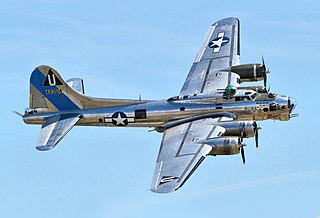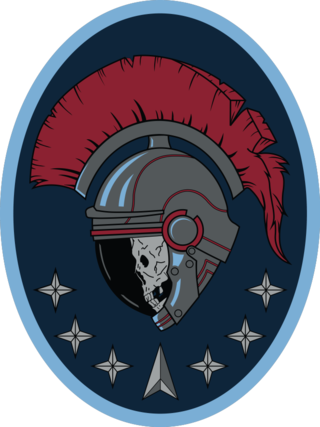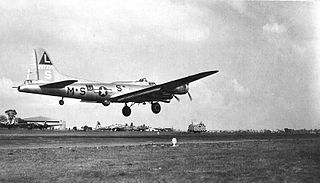
The Boeing B-17 Flying Fortress is a four-engined heavy bomber developed in the 1930s for the United States Army Air Corps (USAAC). Relatively fast and high-flying for a bomber of its era, the B-17 was used primarily in the European Theater of Operations and dropped more bombs than any other aircraft during World War II. It is the third-most produced bomber of all time, behind the four-engined Consolidated B-24 Liberator and the multirole, twin-engined Junkers Ju 88. It was also employed as a transport, antisubmarine aircraft, drone controller, and search-and-rescue aircraft.

Isle of Man Airport is the main civilian airport on the Isle of Man. It is located in the south of the island at Ronaldsway near Castletown, 6 nautical miles southwest of Douglas, the island's capital. Along with the Isle of Man Sea Terminal, it is one of the two main gateways to the island. The airport has scheduled services to the United Kingdom and the Republic of Ireland.
No. 90 Squadron RAF is a squadron of the Royal Air Force.

Royal Air Force Station Polebrook or more simply RAF Polebrook is a former Royal Air Force station located 3.5 miles (5.6 km) east-south-east of Oundle, at Polebrook, Northamptonshire, England. The airfield was built on Rothschild estate land starting in August 1940.

Royal Air Force Ridgewell or more simply RAF Ridgewell is a former Royal Air Force station located at Ridgewell, 7.5 miles (12.1 km) north west of Halstead, Essex, England.

Royal Air Force Andrews Field or more simply RAF Andrews Field is a former Royal Air Force station located 4 miles (6.4 km) east-northeast of Great Dunmow Essex, England.

Nine-O-Nine was a Boeing B-17G-30-BO Flying Fortress heavy bomber, of the 323d Bombardment Squadron, 91st Bombardment Group, that completed 140 combat missions during World War II, believed to be the Eighth Air Force record for most missions, without loss to the crews that flew her. A different B-17G, painted to mimic the Nine-O-Nine, crashed at Bradley International Airport in Windsor Locks, Connecticut, in October 2019.
Royal Air Force Andreas or more simply RAF Andreas is a former Royal Air Force station in the Isle of Man which was operational between 1941 and 1946. It was built in fields between Andreas and Bride in the north of the island. As was common practice, the station was named after the parish in which it was situated.

Royal Air Force Station Jurby or more simply RAF Jurby is a former Royal Air Force station built in the north west of the Isle of Man. It was opened in 1939 on 400 acres (1.6 km2) of land acquired by the Air Ministry in 1937, under the control of No. 29 Group, RAF. During the Second World War the station was used for training as No. 5 Armament Training Station, No. 5 Air Observer School, No. 5 Bombing & Gunnery School and the No. 5 Air Navigation & Bombing School. In addition RAF Jurby also played host to a variety of operational squadrons.

North Barrule is the second highest peak in the Isle of Man at 565 metres (1,854 ft). From the summit the northern plain of the Isle of Man can be viewed along with the coastlines of Ireland, Cumbria, Wales and Scotland.

The 533rd Training Squadron is a United States Space Force unit. It is assigned to the Space Training and Readiness Command, California, where it trains Space Force personnel on space systems. It was activated in this role in 1994.

The 535th Bombardment Squadron is an inactive United States Air Force unit. During World War II, the squadron engaged in combat in the European Theater of Operations, earning two Distinguished Unit Citations. It returned to the United States and was inactivated at Sioux Falls Army Air Field, South Dakota after V-E Day, but was active in the reserve from 1947 to 1949, although it is not clear whether it was fully equipped or manned.

The 534th Training Squadron is an inactive United States Air Force unit. It was last assigned to the 381st Training Group at Vandenberg Air Force Base, California, where it conducted qualification training for airmen in satellite control operations and maintenance.
This is a partial list of accidents and incidents involving the Boeing-designed B-17 Flying Fortress. Combat losses are not included except for a very few cases denoted by singular circumstances. A few documented drone attrition cases are also included.

Yankee Lady is a Boeing B-17 Flying Fortress, owned by the Yankee Air Museum of Van Buren Township, Michigan. Originally delivered to the U.S military in 1945, the plane did not see combat action; it was used by the United States Coast Guard for over a decade. Purchased by the museum in 1986, it has since been restored to a World War II configuration and is flown for flight experience rides and airshow appearances.

On 30 April 1990, a Royal Air Force Avro Shackleton AEW Mk II aircraft, of No. 8 Squadron RAF, based at RAF Lossiemouth, crashed into a hill on the Isle of Harris whilst attempting to land at RAF Benbecula. All ten crew on board died in the crash, which included the wing commander who was in charge of No. 8 Squadron at the time. The Shackleton was the last of the fleet to be involved in a fatal accident, and the type was withdrawn from RAF service in 1991.

Space Delta 1 is a United States Space Force unit responsible for space training. It runs the Space Force's basic military training, weapons school, and other advanced training courses and exercises. It was established on 23 August 2021 following the establishment of the Space Training and Readiness Command, the field command to which it reports. It is headquartered at Vandenberg Space Force Base, California.















